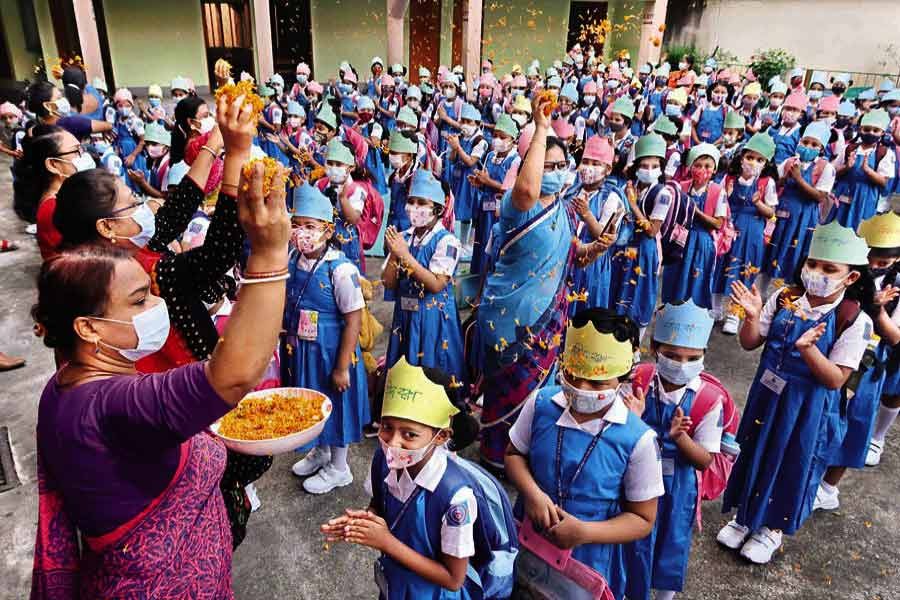
Published :
Updated :

Most people feared a grim impact of the Covid-19 pandemic on school attendance. Accordingly, the situation now being witnessed following the reopening of schools across the country has turned out to be a matter of grave concern.
Several newspapers have published reports on the attendance of students of primary, secondary and higher secondary classes. Unofficial statistics on attendance vary, but what is worrying is the absence of a sizeable number of students, particularly among primary-level classes.
Around 30 per cent of primary school students and 15 per cent of secondary and higher secondary level students are staying away from schools. These data, though unofficial, are indicative of the situation on the ground. The government should immediately ask its all field-level education officials to assess the dropout rates at different levels of education.
More students are likely to return to schools in the coming days if the Covid situation improved further. This is particularly true for urban schools. Some parents and guardians in cities and towns have decided to watch the Covid situation for some more time before sending their kids to schools. Their numbers, however, should not be large.
The decline in the rate of attendance in rural Bangladesh points to a grim situation. A leading English daily published a story that can also be taken as a pointer to some unsavoury developments beyond school attendance.
According to the said media report, a female student of a village school in Lalmonirhat district had eight other female classmates during the pre-pandemic days. When the school reopened on September 12, the said student entered her class to find all her classmates missing. She waited eagerly for a couple of days for their return. But it did not happen. It has transpired that all her classmates have been married off during the period of school closure. These are the glaring cases of violation of child marriage prevention act. Newspapers have published many reports on the widespread violation of the act during the pandemic.
As happens in most other cases, the students belonging to poor and low-income families have taken the main brunt of the pandemic fallout. The main earning members of these families either have lost jobs or sources of income during the pandemic when economic activities came to a halt. A good number of these families had left cities and towns and returned to villages. Some have returned to towns and some others stayed back. Most of these families do not have the means to send back their kids to schools.
Students of middle-class and affluent families of major cities and towns, even during the pandemic, did not lose touch with their educational institutions. Some schools, the English-medium ones, in particular, held online classes regularly while the major Bengali-medium ones organised home-based class assignments to keep the students engaged. The educational institutions, rated as ordinary, remained fully disconnected during the whole pandemic period. Both teachers and students of these institutions suffered badly. The students lost their academic sessions and the teachers their pay packages.
The most affected of all were the kindergartens that have mushroomed in recent years in all corners of the country. It is said thousands of kindergartens have been closed during the pandemic and most of them are unlikely to come to business again. Teachers of these schools have been forced to take menial or odd jobs for the sake of survival. The job of a teacher at kindergartens, though low-paying, still earns some respect for them.
The organised sectors of the economy have come up with the estimated losses they have suffered due to the pandemic. And the government has been prompt to offer stimulus packages to them.
The loss caused to the education sector is difficult to measure. It is also not possible to make up for more than one and a half academic years the students have lost. Also difficult it is to predict when the usual rhythm of academic life will be back. Students, teachers, guardians are eagerly waiting for the return of normalcy to educational activities.
The damage, economic or otherwise, caused by the pandemic is huge. Some sectors would be able to recover sooner or later. But a few might find it difficult to stage a comeback to the old state or close to it.
To address the problems facing the educational institutions in primary, secondary and higher secondary levels, the government will have to initiate a two-pronged programme. The first element of the programme should aim at reviving all the distressed education institutions to their pre-pandemic state. To make it happen, the government will need to offer a one-time grant-in-aid to the needy schools and colleges.
The second element---ensuring the return of the Covid-time dropouts to schools and colleges--- is a bit difficult. The issue is linked to the economic well-being of the parents and guardians of the dropouts. Yet scholarships and incentives, both cash and kind, for families of such students might help.
The government should first make an in-depth assessment of the school dropouts and financial needs of the educational institutions, including the kindergartens, and prepare a massive recovery plan at the earliest.


 For all latest news, follow The Financial Express Google News channel.
For all latest news, follow The Financial Express Google News channel.